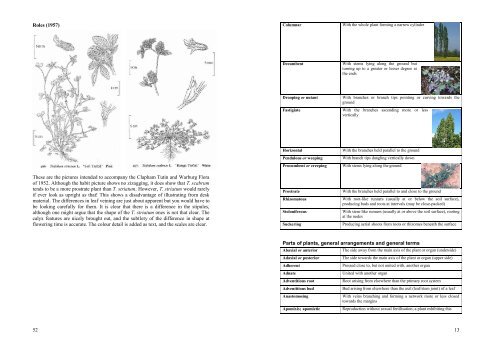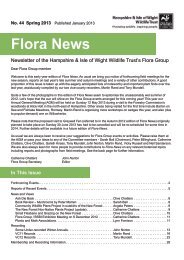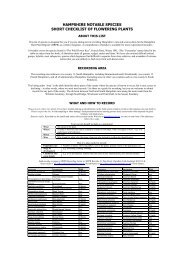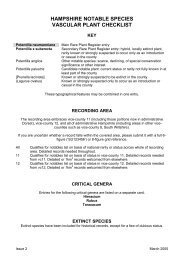An A5 booklet version as distributed in the - Hants Plants
An A5 booklet version as distributed in the - Hants Plants
An A5 booklet version as distributed in the - Hants Plants
You also want an ePaper? Increase the reach of your titles
YUMPU automatically turns print PDFs into web optimized ePapers that Google loves.
Roles (1957)<br />
These are <strong>the</strong> pictures <strong>in</strong>tended to accompany <strong>the</strong> Clapham Tut<strong>in</strong> and Warburg Flora<br />
of 1952. Although <strong>the</strong> habit picture shows no zizagg<strong>in</strong>g, it does show that T. scabrum<br />
tends to be a more prostrate plant than T. striatum. However, T. striatum would rarely<br />
if ever look <strong>as</strong> upright <strong>as</strong> that! This shows a disadvantage of illustrat<strong>in</strong>g from desk<br />
material. The differences <strong>in</strong> leaf ve<strong>in</strong><strong>in</strong>g are just about apparent but you would have to<br />
be look<strong>in</strong>g carefully for <strong>the</strong>m. It is clear that <strong>the</strong>re is a difference <strong>in</strong> <strong>the</strong> stipules,<br />
although one might argue that <strong>the</strong> shape of <strong>the</strong> T. striatum ones is not that clear. The<br />
calyx features are nicely brought out, and <strong>the</strong> subtlety of <strong>the</strong> difference <strong>in</strong> shape at<br />
flower<strong>in</strong>g time is accurate. The colour detail is added <strong>as</strong> text, and <strong>the</strong> scales are clear.<br />
52<br />
Columnar With <strong>the</strong> whole plant form<strong>in</strong>g a narrow cyl<strong>in</strong>der<br />
Decumbent With stems ly<strong>in</strong>g along <strong>the</strong> ground but<br />
turn<strong>in</strong>g up to a greater or lesser degree at<br />
<strong>the</strong> ends<br />
Droop<strong>in</strong>g or nutant With branches or branch tips po<strong>in</strong>t<strong>in</strong>g or curv<strong>in</strong>g towards <strong>the</strong><br />
ground<br />
F<strong>as</strong>tigiate With <strong>the</strong> branches <strong>as</strong>cend<strong>in</strong>g more or less<br />
vertically<br />
Horizontal With <strong>the</strong> branches held parallel to <strong>the</strong> ground<br />
Pendulous or weep<strong>in</strong>g With branch tips dangl<strong>in</strong>g vertically down<br />
Procumbent or creep<strong>in</strong>g With stems ly<strong>in</strong>g along <strong>the</strong> ground<br />
Prostrate With <strong>the</strong> branches held parallel to and close to <strong>the</strong> ground<br />
Rhizomatous With root-like runners (usually at or below <strong>the</strong> soil surface),<br />
produc<strong>in</strong>g buds and roots at <strong>in</strong>tervals (may be close-packed)<br />
Stoloniferous With stem-like runners (usually at or above <strong>the</strong> soil surface), root<strong>in</strong>g<br />
at <strong>the</strong> nodes<br />
Sucker<strong>in</strong>g Produc<strong>in</strong>g aerial shoots from roots or rhizomes beneath <strong>the</strong> surface<br />
Parts of plants, general arrangements and general terms<br />
Abaxial or anterior The side away from <strong>the</strong> ma<strong>in</strong> axis of <strong>the</strong> plant or organ (underside)<br />
Adaxial or posterior The side towards <strong>the</strong> ma<strong>in</strong> axis of <strong>the</strong> plant or organ (upper side)<br />
Adherent Pressed close to, but not united with, ano<strong>the</strong>r organ<br />
Adnate United with ano<strong>the</strong>r organ<br />
Adventitious root Root aris<strong>in</strong>g from elsewhere than <strong>the</strong> primary root system<br />
Adventitious bud Bud aris<strong>in</strong>g from elsewhere than <strong>the</strong> axil (leaf/stem jo<strong>in</strong>t) of a leaf<br />
<strong>An</strong><strong>as</strong>tomos<strong>in</strong>g With ve<strong>in</strong>s branch<strong>in</strong>g and form<strong>in</strong>g a network more or less closed<br />
towards <strong>the</strong> marg<strong>in</strong>s<br />
Apomixis; apomictic Reproduction without sexual fertilisation; a plant exhibit<strong>in</strong>g this<br />
13







